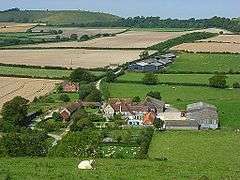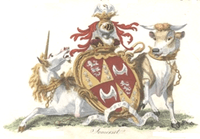Maiden Bradley
| Maiden Bradley | |
 The south-east of the parish forms this projection, of Rodmead Farm and Rodmead Hill. |
|
 The south of the parish including the Long Knoll, a marilyn and Little Knoll (background) |
|
 Maiden Bradley |
|
| Area | 18.62 km2 (7.19 sq mi) |
|---|---|
| Population | 331 (2011 census)[1] |
| – density | 18/km2 (47/sq mi) |
| OS grid reference | ST802389 |
| Civil parish | Maiden Bradley with Yarnfield |
| Unitary authority | Wiltshire |
| Ceremonial county | Wiltshire |
| Region | South West |
| Country | England |
| Sovereign state | United Kingdom |
| Post town | Warminster |
| Postcode district | BA12 7H |
| Dialling code | 01985 |
| Police | Wiltshire |
| Fire | Dorset and Wiltshire |
| Ambulance | South Western |
| EU Parliament | South West England |
| UK Parliament | South West Wiltshire |
| Website | Parish Council |
Coordinates: 51°08′56″N 2°17′06″W / 51.149°N 2.285°W
Maiden Bradley is a village in southwest Wiltshire, England, about 6 miles (10 km) southwest of Warminster and bordering the county of Somerset. The B3092 road between Frome and Mere forms the village street. Bradley House, the seat of the Duke of Somerset, is adjacent to the village.
Maiden Bradley is the principal settlement in the civil parish of Maiden Bradley with Yarnfield. The parish is in the Cranborne Chase and West Wiltshire Downs Area of Outstanding Natural Beauty and was one of the clearings in the former Selwood Forest. In the northwest the parish includes the hamlet of Gare Hill, although most dwellings there are in Trudoxhill parish, Somerset.[2]
Demography
| Output area | Homes owned outright | Owned with a loan | Socially rented | Privately rented | Other | km² roads | km² water | km² domestic gardens | Usual residents | km² |
|---|---|---|---|---|---|---|---|---|---|---|
| Civil parish | 44 | 49 | 5 | 42 | 8 | 0.11 | 0.04 | 0.12 | 331 | 18.42 |
History
Early history
The village takes its name from the leper hospital for maidens founded in the 12th century. Bradley means a wide clearing or wood; Brad = Broad (OE) & Ley = clearing (OE). 1½ miles southwest of the village is the deserted medieval village, now farming hamlet, of Yarnfield. Formerly in the county of Somerset, Yarnfield was transferred to Wiltshire in 1895.[3]
The earliest reference to the village is a Saxon land charter of 878, but the community's origins can be traced back thousands of years. There are numerous tumuli including a Bronze Age barrow opened by Richard Colt Hoare in 1807. It contained a complete skeleton accompanied by numerous items, three of which are on display in the Wiltshire Heritage Museum at Devizes. Other finds include an Iron Age gold coin, Roman remains and a Saxon barrow.
Maiden Bradley was historically in the hundred of Mere in Wiltshire, while Yarnfield was within the Norton Ferris Hundred in Somerset.[3]
The Priory in the medieval centuries

By the mid 11th century Bradley had become a large manor. The lord of the manor was Tostig Godwinson, brother of King Harold. The Domesday Survey assessed it at 4,000 acres (16 km2) worth £10 a year. The men numbered 6 villeins, 13 bordars and 4 slaves. In the early 12th century, the village came into the hands of steward to Henry II of England, Manasser Biset, who owned several manors. In 1154 he decided to found an asylum for girls suffering from leprosy, choosing a site where the present Priory ruins stand. A Proctor and his assistants ran the asylum. In 1189, the Bishop of Salisbury changed the asylum into an Augustinian Priory, dedicated to St. Mary and St. Lazarus. The Priory enjoyed Royal Protection, and prospered until the Dissolution of the Monasteries.
At some time in the mid 15th century the listed building housing the village stores was built by the Lambert family, wool merchants.
The Prior before the Dissolution was elected in 1505 and dispossessed in 1538. The land was awarded by the King to local landowner Thomas Seymour, the brother of the 1st Duke of Somerset, and the property has remained in the family ever since, see below.[4]
Plague during the English Civil War
In 1646 the village was struck by the plague and for 10 months no one was allowed to leave the village. As farming suffered and trading was impossible, the villagers relied on relief provided by neighbouring villages. A story of self-sacrifice as noble and romantic as that of Eyam. In 1671 smallpox broke out, prompting the cancellation of the October fair and market.
Bradley House
Around 1688 Sir Edward Seymour, 4th Baronet deserted his family home at Berry Pomeroy Castle in Devon and used the money derived from stripping that castle to fund improvements to a new house at Bradley[5] that had been started by his father, the 3rd Baronet. A former exceptionally large mansion was completed here 1710 but was replaced in 1820 by today's house which is an eighth of the original footprint.[6]
Beating the bounds
Beating the bounds is recorded as practised each year here in the 18th century. All male residents attended and walked the whole parish boundary. For farmers and everyone able to exercise the usual rights of common on the common land this ensured that by sowing and reaping, taking the natural produce or grazing animals on other peoples' land villagers would not commit aggravated trespass which remains a crime in England and Wales.
Early modern
In 1780 there were three coaching inns in the village. Between 1750 and 1800, three turnpike roads ran through Bradley, to Frome, Wincanton and Bruton. In 1851 the population reached its peak at 619.
The village school was built in 1847 and paid for by the Duke of Somerset. It was enlarged in 1888 to take 130 children. The average attendance at this time was 100. The village hall was built in 1912 and given to the village by Lord Ernest St Maur (Somerset family name) in memory of his brother Lord Percy. During the First World War it was used as a military hospital. (See below: External links – Village Hall Website, for up-to-date information.)
20th century
In the late 20th and early 21st centuries the village population fell to its lowest in at least 200 years; 328 in 1991 and 335 in 2001. Consequently, the school closed in 1969. The Duke of Somerset still lives at Bradley House. The family coat of arms is displayed at the Somerset Arms public house.
There is a local history society in the village.
Geography
Great Bradley Wood and Little Bradley Wood form a large woodland which spans the Somerset border here and occupies a large western tranche of Maiden Bradley parish. It occupies, at between 180m and 104m AOD, the slopes down from the rolling plateau on which the village and its fields lie, which is between 180 and 240 metres AOD. This western woodland has the source of the River Frome, Somerset which continues to drain most of its area. Most of the rest of the parish is drained by porous soil and underground gulleys, being largely chalk subsoil, which slopes gently down to the Wylye on the eastern border which runs from this part of the plateau to Salisbury where it merges with other similar chalk streams.
Places of worship
Three places of worship serve the village.[7]
Baptist
The first Baptist meeting place in Maiden Bradley was licensed in 1834.
Church of England
The Church of All Saints, adjacent to Bradley House, was first mentioned in 1102 but of Saxon foundation. The oldest part of the church is from c.1175 but the majority of the building was completed in 1385. Today it is the principal burial place for the Seymour family and the Dukes of Somerset; church and family cemetery can be reached from the grounds of Bradley House via private access.[8]
Reformed
The Congregational Chapel (now United Reformed Church) serves a third group. A house was first licensed for Congregational worship in 1672 but later licensed for Independent worship. A chapel was built in 1820 and licensed for Independent worship in 1822. It became Congregational and remained so until 1972 when, in common with many other Congregational chapels it became a United Reformed church. The chapel is rendered with a Welsh slate roof, and a plain stone Tuscan portico. A schoolroom was added to the eastern end and there is a 20th-century lean-to extension. Inside there is a late 19th-century gallery on wooden columns and an organ loft.
Public House
The village is served by the Somerset Arms.[9] It is a traditional public house.
Village shop
The village shop opened in 1889. It was a branch of Walton's Department Store of Mere. It sold most things – groceries, clothes, shoes, drapery, even furniture. The village stores is now run by the Maiden Bradley Village Shop Association and the post office is housed in the same building. It is a successful venture and the subject of a Countryside Agency report.[10] The shop also attracted the interest of the BBC.[11]
Representation
The parish is represented in Parliament by the MP for South West Wiltshire, Andrew Murrison, and in Wiltshire Council by Fleur de Rhé-Philipe.
Famous residents or former residents
- In the 17th century, Yarnfield was held by Lieut-General Edmund Ludlow, a regicide and member of the tribunal that condemned Charles I.
- The Duke of Somerset.
Geology
The source of the River Wylye is just south of the village.
The parish lies on fossiliferous chalk and upper greensand.
References
- 1 2 Key Statistics: Dwellings; Quick Statistics: Population Density; Physical Environment: Land Use Survey 2005
- ↑ "Election Maps". Ordnance Survey. Retrieved 22 December 2015.
- 1 2 Baggs, A.P.; Siraut, M.C. (1999). "Victoria County History – Somerset – Volume 7, Bruton, Horethorne and Norton Ferris Hundreds". British History Online. University of London. Retrieved 22 December 2015.
- ↑ Augustinian canons: Priory of Maiden Bradley A History of the County of Wiltshire: Volume 3, ed. R B Pugh and Elizabeth Crittall (London, 1956), pp. 295–302. Accessed 12 December 2014.
- ↑ Report and Transactions of The Devonshire Association for the Advancement of Science, Literature and the Arts. Vol 133 (2001), p 11-12.
- ↑ Historic England. "Details from listed building database (1131122)". National Heritage List for England.
- ↑ "Churches: Maiden Bradley". Wiltshire Community History. Wiltshire Council. Retrieved 13 November 2015.
- ↑ The grave of Algernon Seymour, 15th Duke of Somerset, 19 July 2013
- ↑ "Somerset Arms web site". Retrieved 15 August 2014.
- ↑ Countryside Agency. "Rural Services, Case Study" (PDF). Retrieved 15 July 2009.
- ↑ BBC, Megan Lane (5 November 2003). ""Ideas that make the World a better place", BBC Magazine". BBC News. Retrieved 15 July 2009.
External links
- Maiden Bradley Village Website
- Village Shop
- Memorial Hall
- Parish Council
- Warminster community blog – Wiltshire Council
- Census – Office for National Statistics
- All Saints Bell Tower
- Local history site
- Listed Buildings
![]() Media related to Maiden Bradley with Yarnfield at Wikimedia Commons
Media related to Maiden Bradley with Yarnfield at Wikimedia Commons